 |
|
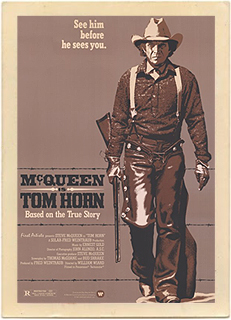 Tom Horn Tom Horn1980. Warner Brother Pictures, Warner Home Video, Color, Aspect Ratio 2.35 : 1, 98 minutes, Rated R Release Date: March 28, 1980 Tom Horn is available at Amazon.com on DVD, as part of The Essential Steve McQueen Collection, and on VHS. Movie Synopsis: In 1901, Tom Horn, a renowned former army scout, is hired by ranchers in Wyoming Territory to hunt down rustlers, but finds himself on trial for the murder of a boy when he carries out his job too well. Cast: Steve McQueen, Linda Evans, Richard Farnsworth, Billy Green Bush, Slim Pickens, Geoffrey Lewis Director: William Wiard Thoughts on the Movie: Now, I think Tom Horn is a great movie. A lot of people didn’t agree. And that’s why, to some extent, this movie remains rather obscure. I absolutely adore Westerns, from all eras and time frames, and maybe that has a lot to do with why I like this movie so much. It’s such a stark, reality-laden type thing, that it lays heavy on you like a big Mexican food meal; but once you digest it, you say, “Yeah, that was good.” And you then consider coming back for seconds. Even though Steve McQueen was in the waning part of his legendary career when he made Tom Horn, he was extraordinary in the film. It sort of reminded me of his movie, Le Mans, where the whole idea was that he would hardly say any dialogue throughout the film (and that, by the way, worked). And although it’s not quite the same, the sort of aching loneliness that pervades this film hits rather hard. While watching the movie, I remember thinking: “Thank God, I didn’t live in those times.” But, having said that, Tom Horn is not really a depressing movie... it’s just kinda real. Need I say more? ~Jean 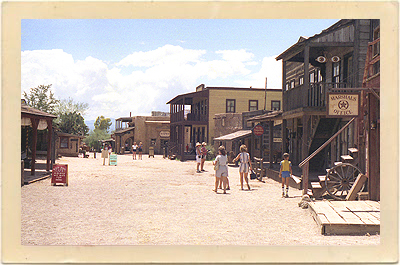 Location Site: Location Site:Old Tucson Studios, Tucson, Arizona (see Map) Old Tucson Studios is located at 201 S. Kinney Road, Tucson, Arizona. Old Tucson Studios was originally built in 1939, by Columbia Pictures on a Pima County-owned site as a replica of 1860s Tucson for the movie, Arizona, starring William Holden and Jean Arthur. Workers built more than 50 buildings in 40 days. Descendants of the Tohono O’odham, Arizona’s first inhabitants formerly known as the Papago, assisted in the set production. Without the convenience of running water, they made more than 350,000 adobe bricks from the desert dirt to create authentic structures for the film. Many of those structures still stand today. Right: Old Tucson Studios was the major location for the 1980 Western, “Tom Horn,” starring Steve McQueen. Here we see Old Tucson circa 1984. After Arizona was completed, the location lay dormant for several years, until the filming of The Bells of St. Mary's (1945), starring Bing Crosby and Ingrid Bergman. Other early movies included The Last Round-Up (1947) with Gene Autry, Winchester '73 (1950) with Jimmy Stewart, and The Last Outpost with Ronald Reagan. The 1950s saw the filming of Gunfight at the OK Corral (1956), The Lone Ranger and the Lost City of Gold (1957), and Cimarron (1959). In 1959, entrepreneur Robert Shelton leased the property from Pima County and began to restore the aging facility. Old Tucson Studios re-opened in 1960, as both a film studio and a theme park. The park grew building by building with each movie filmed on its dusty streets. John Wayne starred in four movies at Old Tucson Studios and each production added buildings to the town. Rio Bravo (1959) added a saloon, bank building and doctor's office; McLintock! (1963) added the McLintock Hotel; El Dorado (1967) brought a renovation of the storefronts on Front Street; and with Rio Lobo (1970) came a cantina, a granite-lined creek, a jail, and a ranch house. Old Tucson also served as an ideal location for shooting scenes for TV series like High Chaparral, Little House on the Prairie, and Father Murphy. 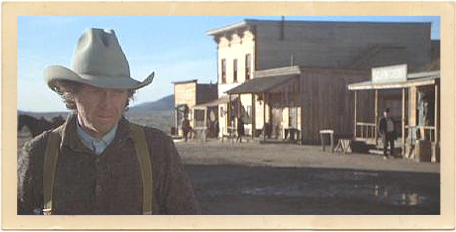 In 1968, a 13,000 square foot soundstage was built to give Old Tucson Studios greater movie-making versatility. The first film to use the soundstage was Young Billy Young (1968), starring Robert Mitchum and Angie Dickinson. The park also began adding tours, rides, and shows for the entertainment of visitors, most notably gunfights staged in the “streets” by stunt performers. In 1968, a 13,000 square foot soundstage was built to give Old Tucson Studios greater movie-making versatility. The first film to use the soundstage was Young Billy Young (1968), starring Robert Mitchum and Angie Dickinson. The park also began adding tours, rides, and shows for the entertainment of visitors, most notably gunfights staged in the “streets” by stunt performers.Right: Steve McQueen in a scene from “Tom Horn.” The Old Tucson Studio Western set can be seen behind him. On April 25, 1995, a fire destroyed much of Old Tucson Studios. Buildings, costumes and memorabilia were all lost in the blaze. Also lost was the only copy of a short film about the history of Old Tucson Studios. This film included rare, behind- the-scenes footage of stars, such as William Holden, John Wayne, and Angie Dickinson. The origin of the fire is still unknown. Most suspect that arson was the cause, however, several factors contributed to the degree of devastation. Fire control efforts were hampered by high winds. Most of the buildings in the studio were classified as “temporary structures,” meaning fire prevention devices, such as sprinklers, were not required. Liquid propane and gun powder stored near the fire area demanded the attention of firefighters, and much of the scarce water supply. So much water was used in the attempt to prevent an explosion that the surrounding areas became flooded, further impeding the firefighters as they attempted to wade through the mud. When the fire began, 300 guests and employees were forced to evacuate the park. After approximately four hours, the flames were finally extinguished. Damages were estimated to be in excess of $10 million, with 25 buildings destroyed, including the soundstage. Among the memorabilia destroyed was the wardrobe from Little House on the Prairie. After 20 months of reconstruction, Old Tucson re-opened its doors on January 2, 1997. The sets that were lost were not recreated; instead, entirely new buildings were constructed, and the streets were widened. The soundstage was not rebuilt. Over the years, the look of Old Tucson Studios has changed quite a bit, since film production companies are generally allowed to make any visual changes that suit their needs. Old Tucson Studios Park is open June 1st through September 30th, Friday through Sunday, 10:00 a.m. to 6:00 p.m. Also open on the 4th of July and Labor Day. The Mescal Set is available for group tours of 10 or more, by appointment only. Schedule and availability of shows and attractions at Old Tucson Studios are subject to change or cancellation due to film projects. From I-10, exit at Speedway and follow the signs. On the way you’ll travese Gates Pass, providing sweeping views of the valleys on both sides of the Pass. From I-19, exit at Ajo Way and follow the signs (this is the best route for RV access). 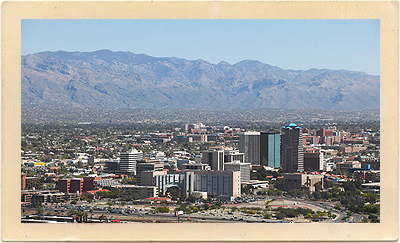 About Tucson, Arizona: About Tucson, Arizona:Tucson, Arizona (population 520,116; elevation 2,389 feet; 32° 13’ 18” N, 110° 55’ 35” W) is located 118 miles southeast of Phoenix on I-10, 60 miles north of the Mexican border. The Tucson skyline is dominated by mountains in every direction. Close in to the city are the Santa Catalina Mountains to the north, the Rincon Mountains to the east, and the Tucson Mountains, closest of all, on the west side. Farther from the city proper, but still commanding the southern sky are the Santa Rita Mountains. The city is located on the Santa Cruz River, which is now a dry river bed for much of the year, with flooding during significant seasonal rains. Right: Modern-day skyline of Tucson, Arizona. Tucson was probably first visited by Paleo-Indians, known to have been in southern Arizona, about 12,000 years ago. And needless to say, a lot has happened between then and now. During the territorial and early statehood periods, Tucson was Arizona’s largest city and commercial center, while Phoenix was the seat of state government and agriculture. The establishment of Tucson Municipal Airport increased its prominence. Between 1910 and 1920, Phoenix surpassed Tucson in population, and has continued to outpace Tucson in growth. Yet, in recent years, both Tucson and Phoenix have been among a list of cities with the highest growth rates in the United States. Similar to many other cities in the Southwest, Tucson was developed on a grid plan starting in the late 19th century, with the city center at Stone Avenue and Broadway Boulevard. While this intersection was initially near the geographic center of Tucson, that center has shifted as the city has expanded far to the east, since development to the west was effectively blocked by the Tucson Mountains. Lodging & Dining: The El Charro Cafe. 311 N. Court Avenue, Tucson, Arizona Tucson’s oldest restaurant, operates its main location in the downtown area. Established in 1922, El Charro Cafe is also the nation’s oldest Mexican restaurant in continuous operation by the same family. Featuring traditional Sonoran cultural style and innovative Tucson style Mexican food, El Charro is truly a taste explosion. 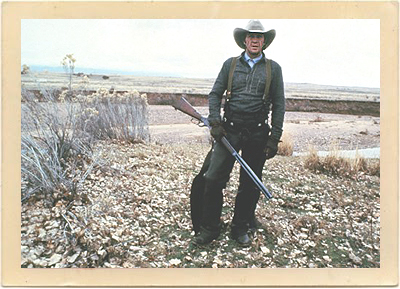 In the late 1890s, Jules Flin built a sturdy home on Court Street, part of the exclusive residential section of Tucson known as Snob Hollow. Snob Hollow lay just outside the area that had encompassed the early Spanish presidio. The house was willed to Monica, his daughter, and is the fourth and present site of El Charro Cafe. The high-ceilinged house is made of the black volcanic basalt rock that characterized most of Flin’s buildings. He quarried the rock from his claim at the foot of “A” Mountain, just west of downtown. It is designated Site Number 14 in El Presidio District on the National Register of Historic Places. Right: Steve McQueen in the open country outside Tucson, Arizona, during the making of the film, “Tom Horn.” Filming Info: Other locations used in Tom Horn were: Mescal and the Coronado National Forest in Arizona; and Nogales, Sonora, Mexico. Movie Trivia: • Steve McQueen thoroughly researched the life of Tom Horn by spending time with famed western novelist, Louis L’Amour, who had many of Horn’s letters in his private collection. • An alternate ending was shot, where the townspeople filed out of the building where Horn was executed. The sole person left in the room was one of the “kid deputies” standing guard at the door. • Five directors worked on this film, but four were either fired or left of their own accord, because of disagreements with Steve McQueen. • The rifle Horn uses to such deadly effect in the film is an original Winchester Model 1876 in .45-60 caliber, fitted with a custom tang sight. Manufactured from 1877-1894, the Model '76 was an obsolete arm by the turn of the century, when the events of the story take place. All the available historical sources state that Horn actually used a .30-30 Winchester Model 1894 for his controversial activities as a "stock detective" in Wyoming. Horn gave this rifle to rancher C.B. Irwin not long before Horn's execution on November 20, 1903. It resides today in the collection of the National Cowboy Hall of Fame in Oklahoma City, Oklahoma. Character Quote: “If you really knew how dirty and raggedy-assed the Old West was, you wouldn’t want any part of it.” ~Tom Horn (Steve McQueen) |
|